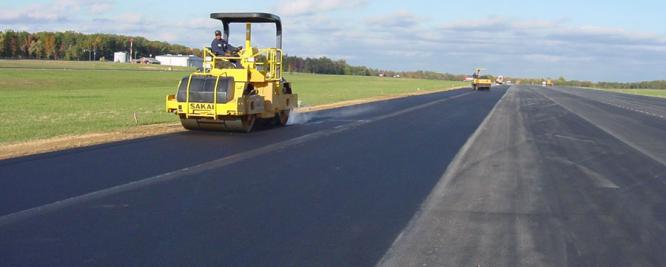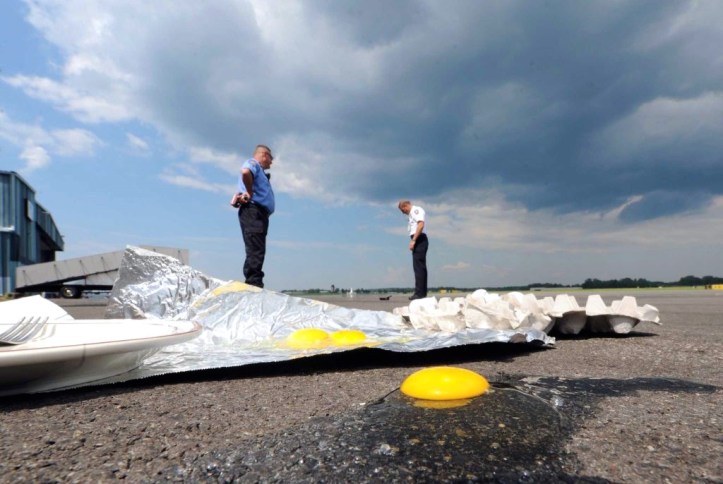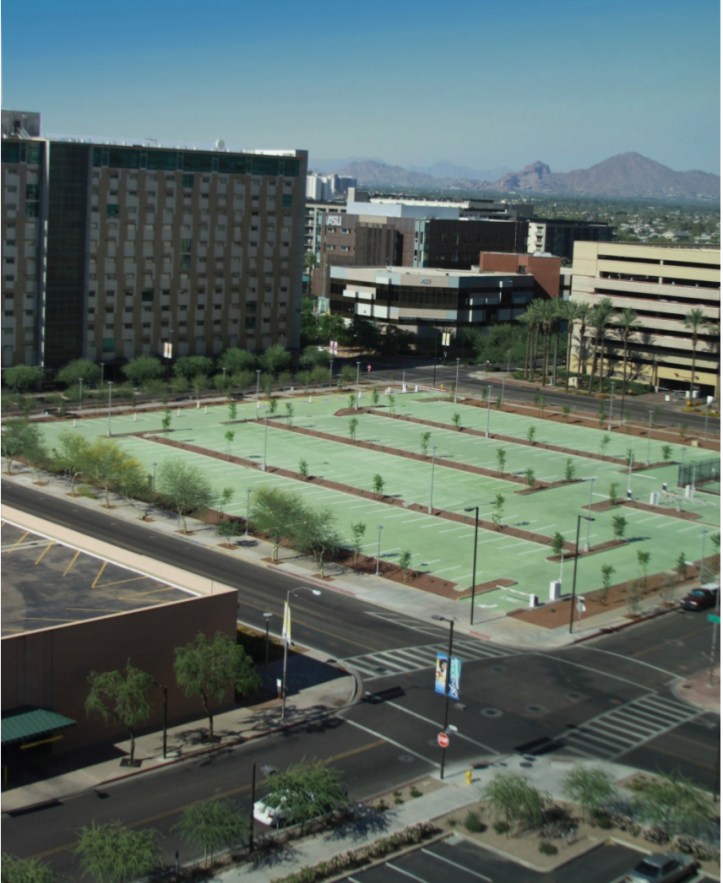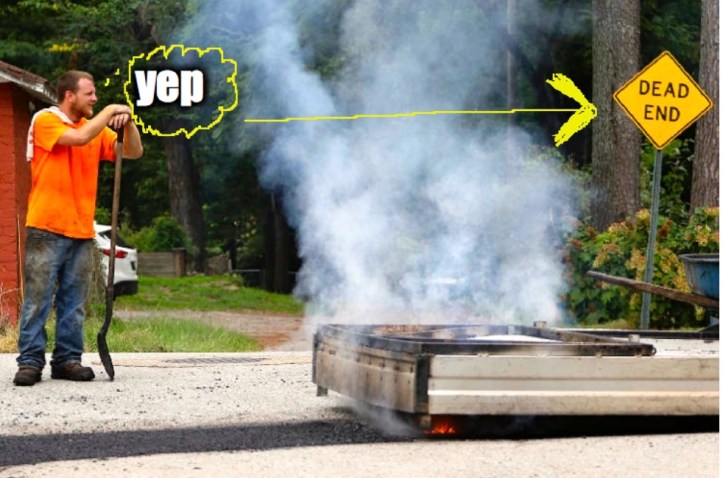And not only streets and rooftops, but also parking lots, airport runways, amusement parks, casinos, car dealerships, school grounds, hospital parking lots and rooftops, everything on top of and around sports arenas (more on that one later) and anything that can be paved or covered…all covered in asphalt.
Think about the tarmac of an airport, or the millions of square miles of asphalt surrounding shopping malls…


Hot, hot, hot. And smelly and oily as hell.
At last check, I had readers in over 190 countries in the world, so it’s a fair bet that it’s summer for at least some of you. But even if it isn’t hot where you live, a simple thought experiment will do: if it’s sunny and warm outside and you put your hand on the surface of a black roadway, how will it feel? Let’s say it’s some time around mid-day. It’s going to feel pretty warm, right? And if the weather is hot enough, chances are that you can fry an egg on that black surface:

In a way, it was this very question about why the roads are black (and thus, hot) which is what got me here, writing about climate change.
To me, it was such a blatantly obvious, illogically bad situation that all of our roadways, rooftops, parking lots, etc., are made of asphalt which just absorbs and traps heat. One of the first articles I came across in 2014 dates back to 2008 can be found here in Daily Kos, titled, “Save the Planet: Paint an Asphalt Parking Lot White.” I found that article in the summer of 2014, when I had decided to devote all of my time to really digging deep and fighting climate change. My four kids had just gone back to school and I signed up and got myself registered as a federal contractor. I began to research where, and how, I could do the most “good,” determined to really make a difference. I thought about all those sizzling hot, heat-absorbing (retaining that same heat) roads, rooftops, and parking lots. Hmm. What if they reflected heat back out into space, instead of keeping it trapped “in,” and making cities essentially, “heat islands” which, of course, also then require more electricity to cool homes, buildings, and vehicles driving around. This led me on a proverbial wild goose chase because the more I searched and asked about why nothing was being done, nothing at all, to simply reflect some of that heat back out (by raising albedo levels), the further down the rabbit hole I got.
Even former Energy Secretary Steven Chu had apparently thought this was a genius idea. In 2008, he said:
“Changing surface colors in 100 of the world’s largest cities could save the equivalent of 44 billion tons of carbon dioxide — about as much as global carbon emissions are expected to rise over the next decade.”
Here he is on YouTube:
To make a long and ugly story short, after speaking to countless people in NGO’s, researchers, scientists in laboratories, and anyone I could get my hands on, my search for someone, indeed, anyone, who had done something about this, led me to one person, only one person, a woman named Sheri Roese, who had thought the same thing about the roads and roofs years before me, and she’d actually done something pretty incredible about it. She had had that “stroke of genius,” but what made her really unique was that she also had enough of a science, business, and design background that she knew how to run with her ideas. Smart lady, and very passionate about climate change. I HAD to find her.
The “finding her” part ended up being easy once I had some of the details. The man who gave me her name also said this, which sent a chill down my spine, and which I scribbled down in my notebook:
“Schatzie, they destroyed her. They shut her down. She won’t want to talk about it, but it was bad, what happened to her.”
Huh? Who is, “they?” The man who gave me this information, which he said in a whisper, was the head of a large NGO. He wasn’t some crackpot who was stockpiling ammunition while wearing a tinfoil hat, and he eventually told me about Sheri and what had happened to her. He probably did this more because he saw I was desperate to understand why no one had done something to solve what I felt was a really obvious part of the problem, which was to just make the roads, roofs, and parking lots reflective.
But about that albedo I mentioned above…
This is super important when trying to understand what’s happening to the climate. First, think about what’s happening in the Arctic. Ice and snow are white. They reflect sunlight away from Earth, meaning that they have a high albedo. As the planet warms, and all of our icy parts melt (which they are), their albedo changes, so instead of having highly reflective (white) surfaces, there is now open water, which is dark and which absorbs (and retains) sunlight and heat, thus creating something called a “positive feedback loop.” In science, a “positive” feedback is actually a bad thing. The more ice melts, the more open water exists, which, again, is darker and more absorbing and retaining of that heat coming from the Sun. The more heat which is retained, the more that any remaining ice melts, and yada yada. Positive feedback = bad stuff speeds up. The word albedo comes from the Latin term for “whiteness,” by the way.
Skeptical Science gives a good explanation of albedo using the IPCC definition:
“The fraction of solar radiation reflected by a surface or object, often expressed as a percentage. Snow-covered surfaces have a high albedo, the surface albedo of soils ranges from high to low, and vegetation-covered surfaces and oceans have a low albedo. The Earth’s planetary albedo varies mainly through varying cloudiness, snow, ice, leaf area and land cover changes.
When sunlight is reflected from something, that sunlight hasn’t been absorbed so it doesn’t contribute to warming that thing. So higher albedo has a cooling effect and lower albedo a warming effect.”
So Sheri Roese said that when she learned how impactful it would be to simply change surface colors to combat climate change, “it was like the light bulb went on in my head. It was so logical…why aren’t we doing this?” Apparently, Sheri found that no one, and nothing, was being done by anyone to actually manufacture the products on a large scale and get them to market, so she used her own money and started a company called Emerald Cities Cool Pavements, and began experimenting with nano reflective technologies. She did the science, made a business plan, and spent four years (initially with the US Department of Energy’s “blessing”) mixing and creating what could have been, indeed, what should have been, the most revolutionary and just downright fucking beautiful bunch of roads and parking lots that you can even imagine. When I say, “imagine,” what I’m referring to, in real life and in splendid color, are the most exquisite hues ever, as in the Emerald City from the Wizard of Oz. I’m not even kidding.

But just like a Grimm fable, there are bad guys. And in this real-world situation, the bad guys are the fossil fuel companies and those that do their dirty work, particularly the American Petroleum Institute, because asphalt, tarmac, roof tops — all of it, are made from petroleum products. Lots and lots of petroleum. I’d say “mountains,” of petroleum, but that would be a gross understatement.
After taking her Cool Cities project so, so far, Sheri Roese was stonewalled, blacklisted, shunned, there was a huge smear campaign against her, both personally and professionally, and all her hard work and passion to combat climate change were for naught. What they (and now I know who “they” are), did to her, and, consequently to all of us, should be a crime.
I spent hours talking with Sheri on the phone in 2014. She seemed pretty emotionally scarred by the whole thing, and I can’t blame her. When I look back at my notes, and my emails from August and September 2014 and see, with my own eyes, how this kind of suffocation of anything that might get in the way of the fossil fuel industry’s profits “works,” it makes me sick to my stomach. For example, Sheri’s company had paved the Sheraton’s parking lot in Phoenix, Arizona. Here is a picture of it:

All during this time and afterwards, the American Petroleum Institute and its associated organizations and sell-out scientists were gunning for her. Here is an example of an industry funded paper (although not initially identified as such, they were later forced to reflect their funding from the Phoenix State Asphalt Pavement Association and the National Asphalt Pavement Association, both part of the American Petroleum Institute), which was called, “Unintended Consequences.”
The supposed scientific findings were run through a shell “Institute” at a university which tried to, and ultimately succeeded in, destroying the concepts that Sheri Roese was working on. If you look at the asphalt-funded paper, scroll to the end of it and see who did the “research.” You can easily find tons of other, similarly scientifically-corrupted work by them and the organizations associated with them. Even more interesting is a response to that asphalt-funded “research paper,“ this one by Kurt Shickman at the Global Cool Cities Alliance which is “discrediting the discrediting” by the fossil fuel industry in their paper which, in the end, killed off Emerald Cities.
Sheri Roese’s Emerald Cities cool pavements are achingly beautiful. Here is a YouTube video which gives you an idea about what it would be like to implement. She did all the work, everything. We’re talking LEEDS credits, pumping station licenses, SO MANY different colors – she thought of everything from A to Z. Imagine, for a moment, what a city, or even your street, would look like in an Emerald Cities “world.” Not only are the array of colors mind-blowing, but the surfaces and finishes are much, much better for the planet. There is no run off, they do not retain heat, nor do they require petroleum…they would be exponentially better for every aspect of the environment. Cooling bills – reduced. Pollution – reduced. Toxic runoff from the asphalt into waterways – reduced. But by the time I’d “found” Sheri Roese, she was so beaten down and disheartened that she was done with the whole thing.
I saw, first hand, what kind of blowback comes when you try to change the system. It was so ugly that it was really almost violent. Let me give you one example.
I live in a big college town, Lexington, Kentucky. If you’re unfamiliar with the University of Kentucky Wildcats men’s basketball team, maybe the saying here that everyone, “bleeds blue,” gives you an idea of how big this team is here.

Everything is blue. That same blue color. There are basketball nets in everyone’s driveway, and they’re blue, too. UK Wildcat blue shirts are at every grocery store, gas station – you cannot escape THE BLUE.

If you need to go to Lowe’s on a Saturday, wait until the UK Wildcats are playing and the city is a ghost town because everyone’s glued to their TV. The University of Kentucky has a huge campus, and it’s getting bigger every day. Like many big schools, they are knocking stuff down all over the place and putting so many new structures and compounds and buildings up that you can’t keep up with it.
After I became a federal contractor, and began looking into the impact of black roofs and roads (and after speaking with Sheri Roese), this led to the ugly realization that the federal government, which is thoroughly entwined with, and controlled by, fossil fuel interests, is the one actually perpetuating global warming. They will not provide a penny of funding to really do anything, except more research, more studies, and more nonsense. If you really want to put something into play, it’s going to be suffocated, like Emerald Cool Cities.
But I had a bright idea. How about I get some of that cool, BLUE pavement onto the University of Kentucky’s campus? At that time, UK was also spending hundreds of millions of dollars to upgrade Commonwealth Stadium for the football team. How about a blue parking lot? Imagine the press coverage? And then UK’s rival, the Louisville Cardinals (they’re red) would surely need to up their game with nano reflective red paint, right? TV cameras, word of mouth and BOOM! This would mean the further realization that rooftops, parking lots to campuses, and hospitals – the whole enchilada, could match any university’s colors and because universities are all about civic responsibility, the environment, sustainability, and all that good stuff, this would be a slam dunk., right? Wrong.
As the saying goes, “not even wrong.” Here I am in Lexington, my son goes to UK, so they have to listen to me, right? There are hundreds of millions of dollars in construction and upgrades. Surely I can get this idea in somewhere (said the eager and excited mom trying to save the planet). Hell, I even told them that I’d apply the paint and coatings myself (with my kids help). Nada. Everywhere I looked for a way “in,” I was shut down. I took photos of areas around the athletic department (which is like the Hollywood Walk of Fame) to illustrate how incredible it would look. Nothing. I spoke with sustainability directors, different departments, contractors, architects for the University – it was so disheartening. And not only that, but it got really, really ugly. Just so you know, I’m not a Birkenstock wearing hippy (not that there’s anything wrong with that). I have a Master’s degree, I know how to conduct myself, and some might say I can be charming. Still nothing. Worse than nothing, actually.
During one conversation with the head architect for the University of Kentucky, Warren Denny, he became extremely hostile towards me on the phone, yelling, “what do you want from me?” Whoa. Where the hell did that come from? So I explained, in the most simplistic terms possible, that I wanted UK to become (actually) environmentally responsible instead of just saying they were, and I wanted them to do something to combat climate change during their very expensive expansion and renovation campaigns. Warren Denny told me he didn’t believe that climate change was “a thing.” I didn’t even know where to file that in my brain. “A thing.” I couldn’t believe he actually said it out loud, you know? He then said that he’d read plenty of studies that cool roofs and cool pavements actually make everything (his word) worse. I asked him where he’d read it. He couldn’t remember.
Not to be put off, I followed up with this email to Warren Denny:
On Sep 9, 2014, at 11:35 AM, Schatzie wrote:
Hi Mr. Denny – Thank you for taking the time to speak with me today. Just a few links:
Environmental Protection Agency’s “Cool Pavements” page: http://epa.gov/heatislands/mitigation/pavements.htm
Lawrence Berkeley National Laboratory page about the benefits of cool pavements and roofs: http://heatisland.lbl.gov
Department of Energy Secretary Chu 1 minute YouTube video and accompanying article about benefit of cool roofs/pavements: http://energy.gov/articles/cool-roofs-lead-cooler-cities
Global Cool Cities Alliance has a lot of information about “cool buildings:” http://www.globalcoolcities.org
Website of company which has developed and markets the nano technology for cool pavements: http://emeraldcoolpavements.com
You asked me what it was exactly that I wanted. What I “want” is to have UK use cool pavements to decrease CO2 emissions in our city. The Emerald Cities President, Sheri Roese has documented the results of her product and I feel quite confident that those results are verified and repeatable. I would help you in any way possible to see this product at work if you want my help. The only negative reports about this method of decreasing urban temperatures and carbon footprints come from the Asphalt Pavement Association/Alliance and their interest in maintaining the status quo is quite transparent.
Additionally, you mentioned that there was substantial information about the perils of adopting cool roofs and pavements. I would greatly appreciate any links you have in that regard so that I can better understand this subject.
Thank you,
Schatzie
Proud UK parent
So this is what I got back from him:
On Sep 10, 2014, at 11:33 AM, Denny, Warren <wedenn00@email.uky.edu> wrote:
I will forward this info to our Sustainability Director.
Warren Denny was (is?) the head architect for the whole university. He’s trying to send me to the sustainability director (Shane Tedder)? Nope. Not going to be that easy, dude:
From: Schatzie
Sent: Wednesday, September 10, 2014 12:12 PM
To: Denny, Warren
Cc: Tedder, Shane
Subject: Re: Cool pavement documentThanks so much, Mr. Denny.
I would also appreciate receiving a link to the studies you mentioned to me on the phone which state that “cool roofs” worsen climate change and global warming.
Best regards,
Schatzie
But things were getting “testy” since I’m copying people on some of the emails that Warren “No such thing as climate change” Denny works with, who probably don’t realize that he’s such a tool. He responds with this:
On Sep 10, 2014, at 2:21 PM, Denny, Warren <wedenn00@email.uky.edu> wrote:
I did not book mark my readings since they confirmed my suspicions that all is not as simple as it appears. The articles that relate to Kentucky are easy to find and consistent in findings about degree days in our area (we heat more than cool).
Going downhill fast at this point, but since I have nothing to lose (and I’m sending him stuff from the American Institute of Architects – he’s an architect!) and I don’t appreciate being talked down to…
On Sep 16, 2014, at 11:46 AM, Schatzie wrote:
Mr. Denny:
Something that “confirms your suspicions” and prevents you from looking at valid scientific evidence which does not conform with your beliefs is called “confirmation bias.” Casually dismissing my request for your evidence that cool roofs & pavements actually make climate change “worse” (your words) is unacceptable considering that you are the architect for a major university which is undergoing extensive construction/renovation. And, given that you believe that global warming is “debatable” (again, your words) and it, frankly, is not, leads me to think that you are unwilling to look further into this vital issue. As a mother of four children, I am very concerned that we are ruining my children’s future and saddling them with a growing problem that our generation simply will not deal with.With that said, in addition to all the other links I have sent you which are contained in this email, I am sending you additional information below which has broad-based and uniformly affirming evidence that having cool roofs and cool pavements will measurably decrease greenhouse gases. The Sika Roofing articles are extremely useful and have additional links on the right side of their initial article:
Fact sheet by the American Institute of Architects about cool roofs: http://www.aia.org/akr/Resources/Documents/AIAP027077
Fact sheet by the American Institute of Architects about mitigating the urban heat island effect with cool roofs and pavements: http://www.aia.org/akr/Resources/Documents/AIAP027079
This article is written by a Sika Roofing Company employee (Stanley Graveline) who also speaks at LEED conferences. It has a lot of excellent links to more information about cool roofs: http://usa.sarnafil.sika.com/en/group/roofing-sustainability/sustainable-product-solutions/cool-roofs.html
NASA’s satellite observation and article about cooling roofs: http://earthobservatory.nasa.gov/Features/GreenRoof/greenroof2.php
Architectural Record article about cool roofs: http://continuingeducation.construction.com/article.php?L=68&C=790&P=1
I don’t know what you are referring to when you say, “the articles that relate to Kentucky are easy to find…” I didn’t ask about the weather here. Perhaps you misunderstood a comment I made. I look forward to hearing from you.
Schatzie
And finally, the kiss off…
From: “Denny, Warren” <wedenn00@email.uky.edu>
Subject: Re: Cool pavement document
Date: September 16, 2014 at 4:06:04 PM EDT
To: Schatzie DudeeI defer to Shane Tedder to respond to your concerns/advice as appropriate . While I pay attention to research regarding sustainable practices my role does not include setting policy related to sustainability issues. My conversation with you was focused on trying to understand what you wanted me to do with the information you wished to share with UK. Since you copied Shane on your follow up e-mail I won’t need to do that. Have a good day.
“Have a nice day.”
“Go to hell, lady” is what he meant. He just didn’t have the balls to say it. I would have been happy with a walkway, maybe in front of the athletic department, or, to be honest, practically anything that would garner this incredible technology some attention. Because cool pavements are just that cool. How neat would that be to both have stuff you’re walking on and parking on which is in your school’s colors, AND be doing something to help the environment? I’d say it’s a “no brainer,” except that would imply that Warren Denny had a brain to start with.
Much like Swarthmore College’s Board, which refuses to divest from fossil fuels, I suspect that UK’s bilge and bluster about caring about anything other than money and big donations (we are, after all, in coal country here in Kentucky) is just that.
The answer to my own question about why rooftops and streets are black is as insanely simple as the answer to the question about how to combat climate change, which is exactly four words long: stop burning fossil fuels. Those surfaces were, and are, black because the American Petroleum Institute, funded by the fossil fuel industry, wants them that way.

.
Further reading about cool roofs and pavements:
http://energy.gov/articles/cool-roofs-lead-cooler-cities
https://heatisland.lbl.gov
https://www.epa.gov/heat-islands
http://usa.sarnafil.sika.com/en/group/roofing-sustainability/sustainable-product-solutions/cool-roofs.html
http://earthobservatory.nasa.gov/Features/GreenRoof/greenroof2.php
http://landcover.usgs.gov
http://www.tmm.eu.com

Thank you dear Schatzie , this is once again a brilliant Labor of Love and determination ! and its totally do able and grand in its Simplicity ! and just think the billions of Jobs this will create ! ! ! Bless Sheri Roese for pioneering this concept ! The beauty and functionality of Emerald Cities …this simply must be made manifest ! thinking about this actually makes my Heart sing…..[ the first time my Heart is not weeping over the destruction of our earthly Home ~~~] Oh how much I wish I could help you . Right now I am very worn from fighting to save our Planet and its precious Creatures ! …plus have a serious Health Issue ..I will forward this Newsletter to my friends….some who are young and full of Hope ! ~~~ and invincible as I once was ! ! ! May this be the turning point ! Schatzie : This simply must be implemented in every Country ! and ASAP !
Bless you , Johanna
LikeLiked by 1 person
Thank you so much for your kind words, Johanna! Indeed – “Bless Sheri Roese!” It was such a labor of love for her, and, I fear that she’s just been beaten down by those who don’t ever want her great idea to see the light. This is why I wrote about it. An Emerald City would be breathtakingly beautiful, wouldn’t it?
LikeLiked by 1 person